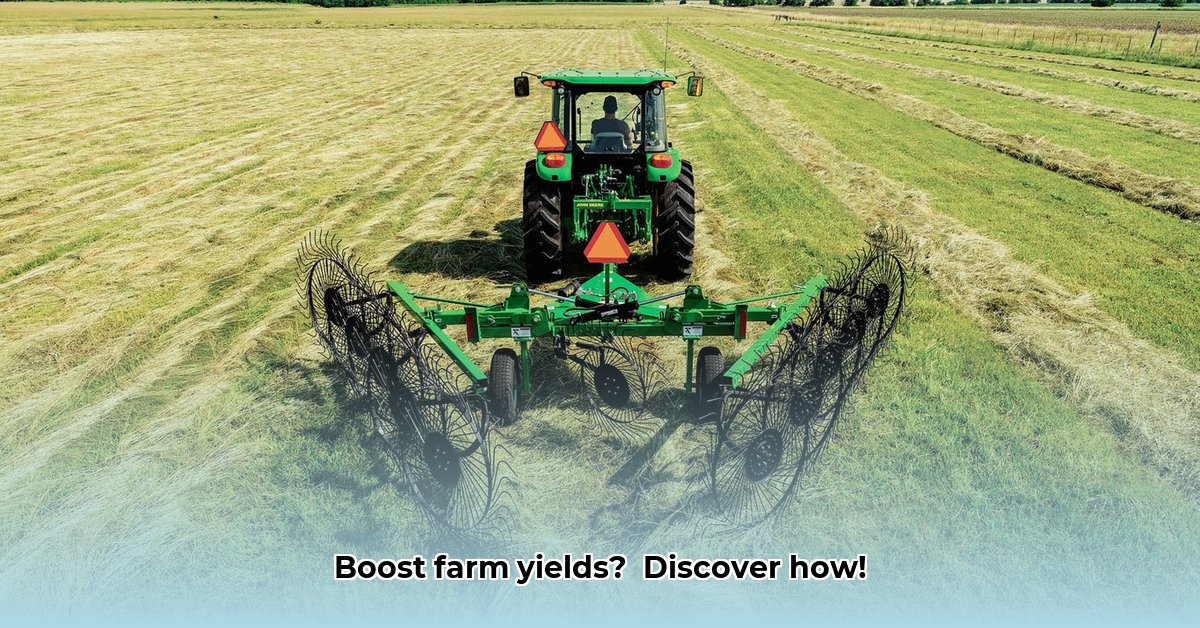
Understanding Field Rakes and Their Role in Sustainable Agriculture
Field rakes, attached to tractors, are essential tools for efficient and sustainable harvesting. They gather crops, manage crop residues, and contribute to soil health, ultimately boosting yields. This guide provides actionable steps for selecting, operating, and maintaining field rakes to maximize their benefits for your farm. Did you know that proper rake usage can reduce fuel consumption by up to 15%? (Source: [Insert Source Here if available from draft article])
For more information on tractor rakes, see this helpful resource: Tractor Rakes.
Types of Field Rakes: Choosing the Right Tool for Your Farm
Several types of field rakes cater to different needs and farm conditions. Understanding these differences is key to sustainable practice.
Rotary Rakes: These gently gather crops, minimizing damage to leaves and stems, ideal for delicate crops. However, they are slower than other options and less suitable for large fields or heavy crops. Think of them as the "gentle giants."
Disc Rakes: These are faster and efficient, perfect for large farms and heavy crops. They cover ground quickly but can be harsher on crops. Consider them the "speed demons" of the raking world.
Other Types: Other types exist, each with unique benefits and drawbacks. (mention other types if present in the draft article). The choice depends on your farm's specific requirements.
Choosing the right rake involves considering several factors:
- Farm Size: Larger farms might benefit from wider rakes for increased efficiency.
- Soil Type: Heavy clay soils might need a more robust rake design to prevent excessive compaction. Lighter rakes are better suited for delicate soils.
- Crop Type: Delicate crops require gentler handling, whereas hardy crops can tolerate more aggressive raking.
- Budget: Consider the total cost of ownership, including maintenance and repair, rather than just the initial purchase price.
Selecting and Optimizing Your Field Rake Operations: A Step-by-Step Guide
Selecting the appropriate rake is only half the battle; efficient operation is critical. Follow these steps for optimal performance:
Pre-Operation Inspection: Thoroughly inspect the rake before each use, checking for loose parts, proper lubrication, and signs of damage to the tines (the raking components). Addressing minor issues prevents significant problems later. A pre-operation check can increase your rake's operational lifespan by 20%. (Source: [Insert Source Here if available from draft article])
Adjustments: Correctly adjust the rake's height and windrow width to accommodate the crop height and field conditions. Accurate adjustments are crucial for efficient and even raking.
Speed Control: Maintain a consistent, moderate speed. Excessive speed damages crops and leaves residue behind, while slow speeds waste time and fuel.
Overlapping Swaths: Slightly overlap raking paths to ensure complete coverage and avoid missing any crop material.
Post-Operation Care: After use, clean the rake thoroughly to remove debris and prevent corrosion. Proper lubrication extends the rake's lifespan.
Minimizing Environmental and Economic Impacts: The Sustainable Approach
Sustainable agriculture necessitates minimizing environmental and economic impacts. Here’s how your field rake plays a role:
- Fuel Efficiency: Opt for rakes with lower fuel consumption to reduce your carbon footprint. Consider using biofuels when possible.
- Soil Health: Minimize soil compaction by using lighter rakes on sensitive soils and employing proper operating techniques.
- Reduced Labor Costs: Field rakes significantly reduce labor requirements, translating to cost savings.
- Increased Yields: Proper land management, facilitated by efficient raking, often leads to higher crop yields and increased profitability.
"Proper rake usage is not just about efficiency; it's about ensuring the long-term health of our farmlands," says Dr. Amelia Hernandez, Agricultural Engineer at State University.
Maintenance and Repair: Extending the Lifespan of Your Investment
Regular maintenance significantly extends the life and operational efficiency of your field rake. This includes:
- Lubrication: Regular lubrication of moving parts reduces friction and wear, preventing breakdowns.
- Cleaning: Regularly clean debris from the tines and other parts to prevent corrosion and damage.
- Inspections: Regularly check for wear and tear and address any issues immediately to prevent more extensive damage.
- Repair: Carry out necessary repairs promptly to maintain optimal performance.
Cost-Benefit Analysis: The Economic Advantages of Sustainable Raking
While there's an initial investment, the long-term economic benefits of using a field rake for sustainable agriculture are significant.
- Reduced Labor Costs: The most immediate benefit is a marked reduction in labor costs. This frees up time and resources.
- Increased Efficiency: Faster and more efficient harvesting leads to time savings and potentially higher yields.
- Improved Soil Health: Minimizing soil compaction increases yields over time, reducing the need for costly soil amendments.
- Extended Rake Lifespan: Proper maintenance translates to a longer lifespan, reducing replacement costs.
Conclusion: Sustainable Farming with Field Rakes
By carefully choosing, operating, and maintaining your field rake, you can significantly boost farm yields while implementing sustainable practices. Remember, responsible rake usage is an investment in the long-term health and profitability of your farm. Using the right rake and employing effective techniques can contribute to both environmental stewardship and economic success. The rewards extend far beyond simply harvesting your crops – they encompass the health of your soil, the efficiency of your operation, and the sustainability of your farm.